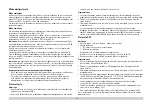
9
Multi-Protocol Operation
Analog Operation
This decoder can also be operated on analog layouts or areas of track that are
analog. The decoder recognizes alternating current (DC) and automatically adapts
to the analog track voltage. All functions that were set under mfx or DCC for analog
operation are active (see Digital Operation).
The built-in sound functions come from the factory inactive for analog operation.
Digital Operation
The decoders are multi-protocol decoders. These decoders can be used under the
following digital protocols: mfx or DCC.
The digital protocol with the most possibilities is the highest order digital protocol.
The sequence of digital protocols in descending order is:
Priority 1: mfx; Priority 2: DCC; Priority 3: DC
Note:
Digital protocols can influence each other. For trouble-free operation, we re-
commend deactivating those digital protocols not needed by using CV 50. Deactivate
unneeded digital protocols at this CV if your controller supports this function.
If two or more digital protocols are recognized in the track, the decoder automatically
takes on the highest order digital protocol, example: mfx/DCC; the decoder takes on
the mfx digital protocol (see previous table).
Note:
Please note that not all functions are possible in all digital protocols. Several
settings for functions, which are supposed to be active in analog operation, can be
done under mfx and DCC.
Notes on digital operation
• The operating instructions for your central unit will give you exact procedures for
setting the different parameters.
• The values set at the factory have been selected for mfx in order to guarantee the
best possible running characteristics.
Adjustments may have to be made for other operating systems.
mfx Protocol
Addresses
• No address is required; each decoder is given a one-time, unique identifier (UID).
• The decoder automatically registers itself on a Central Station or a Mobile Station
with its UID-identifier.
Programming
• The characteristics can be programmed using the graphic screen on the Central
Station or also partially with the Mobile Station.
• All of the Configuration Variables (CV) can be read and programmed repeatedly.
• The programming can be done either on the main track or the programming track.
• The default settings (factory settings) can be produced repeatedly.
• Function mapping: Functions can be assigned to any of the function but-
tons with the help of the 60212 Central Station (with limitations) and with the
60213/60214/60215 Central Station (See help section in the Central Station).
DCC Protocol
Addresses
• Short address – long address – multiple unit address
• Address range:
1 – 127 for short address and multiple unit address,
1 – 10239 for long address
• Every address can be programmed manually.
• Short or long address is selected by means of CV 29 (Bit 5).
• A multiple unit address that is being used deactivates the standard address.
Programming
• The characteristics can be changed repeatedly using the Configuration Variables (CV).
• The CV numbers and the CV values are entered directly.
• The CVs can be read and programmed repeatedly. (Programming is done on the
programming track.)
• The CVs can be programmed in any order desired. (PoM - Programming can be done
on the main track). PoM is not possible with CVs CV 1, 17, 18, and 29. PoM must be
supported by your central controller (Please see the description for this unit.).
• The default settings (factory settings) can be produced repeatedly.
• 14 or 28/126 speed levels can be set.
• All of the functions can be controlled according to the function mapping (see CV
description).
• See the CV description for the DCC protocol for additional information.
We recommend that in general programming should be done on the programming
track.
Содержание 26817
Страница 1: ...Modell der HSB Dampflok 99 72 26817...
Страница 2: ...2...
Страница 37: ...Erweiterte Decoderwerte Werkseinstellung 26817...










































